On June 1, Gov. Gretchen Whitmer lifted the Stay-at-Home Order and several restrictions for retail, restaurants and bars and other businesses because the State has seen a serious improvement in the number of new daily cases and deaths, meaning the curve has flattened.
According to the State of Michigan, the total number of COVID cases in Michigan rose to 57,532 on June 1, an increase of 135 cases from the previous day. The daily total was equivalent to 576 cases per 100,000 people (Chart 4). Of those 135 cases, 57 were documented in Southeastern Michigan, which was equal to 42 percent of the new cases. In Chart 1 we show that the State total for the number of COVID cases on May 30 was 56,890–a five-day rolling average. The five-day rolling average for the total number of COVID cases (Chart 1) reflects a smoother curve and adjusts for fluctuations in testing and/or the quality of reporting or failure to report.
Chart 2 shows that, based on the five-day rolling averages, the growth of new COVID cases in Southeastern Michigan continued to level off for the counties in the region, likely one of the many factors as to why Whitmer decided to moved forward in lifting the Stay-at-Home Order. On May 30, the number of cases in Detroit reached 10,974, the highest in the region, and Wayne County reported the second highest number of cases at 9,307. On May 30, the five-day rolling average for the number of COVID cases in Oakland County was 8,343, and Macomb County reported 6,646.
The City of Detroit had 1,644 COVID cases per 100,000 people as of June 1, an increase from 1,641 the day before (Chart 3). This is based upon a reported increase of 17 new COVID cases, bringing the total number of COVID cases in Detroit to 11,058. Wayne County reported 872 cases per 100,000 people, and Oakland County had 669 cases per 100,000 people. These per capita rates were based upon 9,388 total cases for Wayne and for 8,407 Oakland. Macomb County reported 767 cases per 100,000 people, which is based upon 6,707 cases.
The daily data highlighted in these posts is from Michigan.gov/coronavirus, where data is updated daily at 3 p.m. Historical data were supplied from covidtracking.com, which republishes COVID data from the State. Additionally, the case totals do not reflect the number of people who have recovered, just those who have been infected.
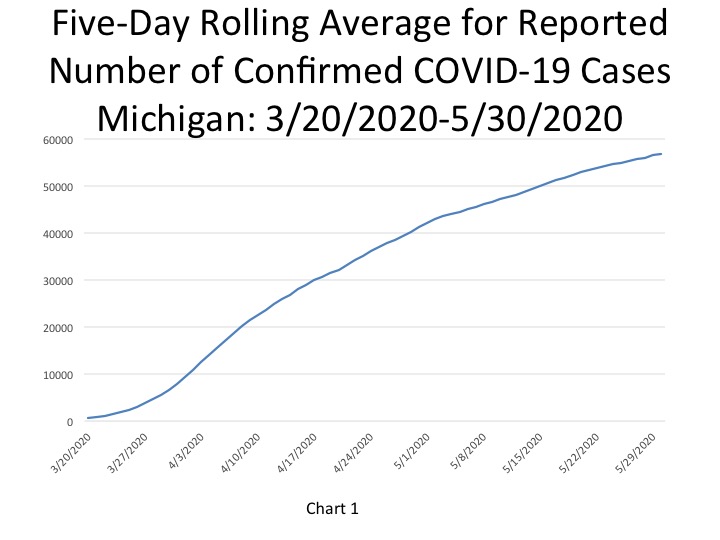
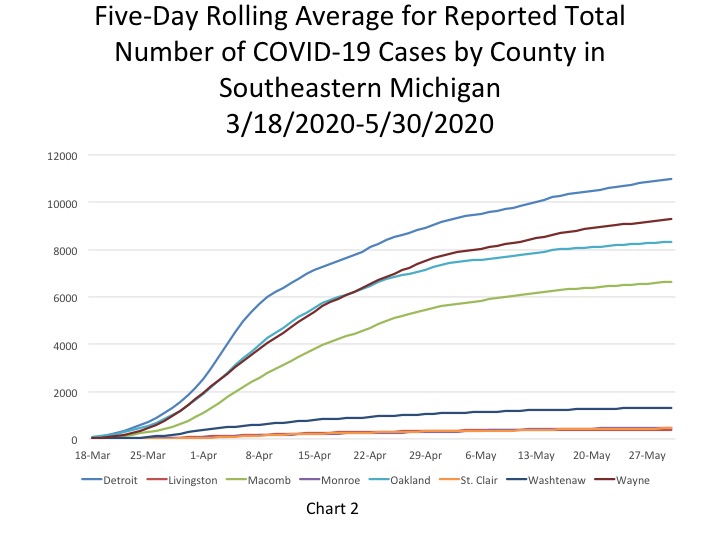
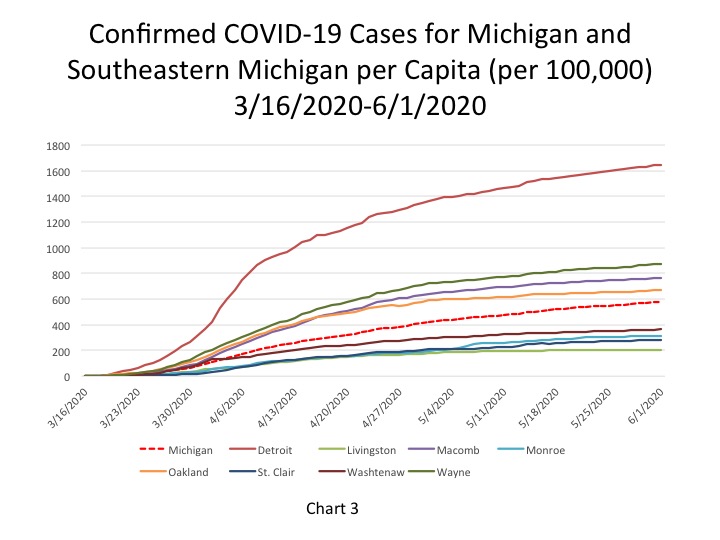
Chart 4 shows that Wayne County, among the units covered here, reported the highest number of daily cases at 52 on May 30 and Detroit reported 37 new cases. The numbers reported in this chart reflect a five-day rolling average.
On June 1, the per capita rate for the number of new daily COVID cases per 100,000 people was 1 for the State, which was equivalent to 135 new cases. The State’s June 1 per capita rate was a decrease from the day prior, which is when the number of new cases nearly doubled. Just as the State’s per capita rate dropped so did the City of Detroit’s. On May 31, Detroit reported 14 new COVID cases per 100,000 people, and on May 1 it reported a rate of 3. Detroit’s increased rate was equivalent to 17 new cases (Chart 5). Wayne County reported 1 new COVID case per 100,000 people, which was equivalent to 14 new cases. Oakland and Macomb counties also each reported per capita rates of 1 new case per 100,000 people on June 1, which were equivalent to 11 and 12 new cases, respectively. Overall, 57 new COVID cases were reported in Southeastern Michigan on June 1. This is a decline of 263 from the day prior.
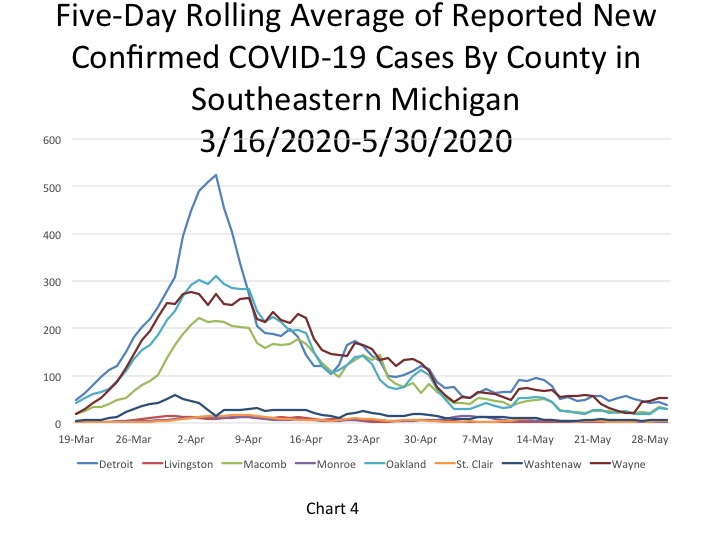
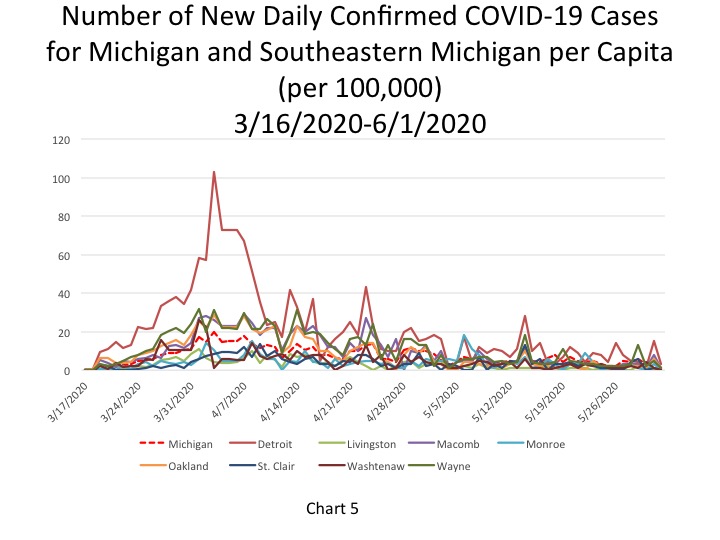
In Chart 6, the five-day rolling average for the number of deaths in Michigan shows a continuing slow increase (a lagged number of 5,450 deaths, an increase of 36 deaths). The actual reported COVID-19 deaths on June 1 was 5,516, an increase of 25 deaths from the day prior. Of those 25 deaths Southeastern Michigan accounted for 12 of them.
Chart 7 (a 5-day rolling average) portrays how Detroit continues to report the highest cumulative number of deaths at 1,365 on May 30. Wayne County had the second highest total at 1,077 on May 30.
Chart 8 portrays the total number of COVID deaths per 100,000 people on June 1. The cumulative total of COVID deaths per 100,000 people remained the same for Detroit and all the counties in the region due to the small increases in the number of deaths, which totaled 12 for all of Southeastern Michigan. In Detroit the per capita rate remained at 204 (representing 1,375 deaths). In Wayne County there were 101 COVID deaths per 100,000 people (1,088 total deaths). In Oakland County there were 79 deaths per 100,000 people (988 total deaths), and in Macomb County there were 93 COVID deaths per 100,000 people (814 total). Macomb County had the highest single day death count in Southeastern Michigan on June 1; 4 COVID deaths were reported. The State of Michigan had 55 COVID deaths per 100,000 people, which was equal to 5,516 total deaths. The State’s per capita rate did increase by 1.
Chart 9, the five day rolling average of deaths, shows the number of new statewide deaths declined to 36 on May 30. Furthermore, Chart 10 shows how the number of deaths in Southeastern Michigan declined. Detroit reported 6 daily COVID deaths, as did Wayne, Oakland and Macomb counties on May 30. The 6 daily deaths in each of those three counties and Detroit were the highest reported in the region. These numbers are based on five-day rolling averages.





The fatality rate trends continued in Southeastern Michigan on June 1 with the State reporting a fatality rate of 9.6 percent for two weeks straight, Detroit continuing to report a fatality rate of 12.4 percent and Macomb County reporting a fatality rate of 12.1 percent for another day.
One reason we may be seeing such high fatality rates in Michigan is due to the low testing rates. When only having-presumably-a lower of number confirmed COVID cases than is actually likely due to the limited availability of tests, the fatality rate appears higher because the base comparison is smaller than it might be.

Although the Stay-at-Home Order has been lifted and business restrictions have been loosened to the point where many can open with capacity limitations, there are still concerns of a second wave. This is why policies to wear masks inside and work from home when possible are still encouraged. We must find a balance to ensure the health and safety of our communities remain a priority while opening the economy.